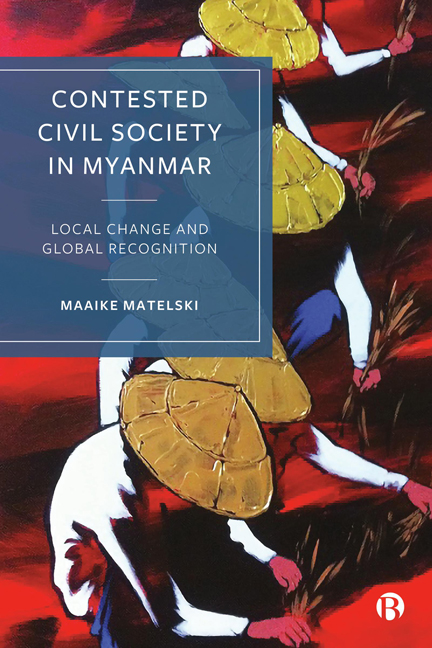Book contents
- Frontmatter
- Contents
- List of Abbreviations and Acronyms
- Acknowledgements
- Introduction: Contested Representation in Burma/Myanmar
- 1 Conflict, Repression and Resistance from Colonialism to Military Rule
- 2 Constructing Civil Society in Myanmar
- 3 Diversity and Fault Lines in Burmese Civil Society
- 4 Room to Manoeuvre under Authoritarian Rule
- 5 Transnational Advocacy Strategies and Pathways to Change
- 6 Competing Frames around the 2010 Elections
- 7 Foreign Aid and the (De)politicization of Civil Society Assistance
- 8 Interrupted Transition and Post-coup Resistance
- Conclusion
- Notes
- References
- Index
2 - Constructing Civil Society in Myanmar
Published online by Cambridge University Press: 28 March 2024
- Frontmatter
- Contents
- List of Abbreviations and Acronyms
- Acknowledgements
- Introduction: Contested Representation in Burma/Myanmar
- 1 Conflict, Repression and Resistance from Colonialism to Military Rule
- 2 Constructing Civil Society in Myanmar
- 3 Diversity and Fault Lines in Burmese Civil Society
- 4 Room to Manoeuvre under Authoritarian Rule
- 5 Transnational Advocacy Strategies and Pathways to Change
- 6 Competing Frames around the 2010 Elections
- 7 Foreign Aid and the (De)politicization of Civil Society Assistance
- 8 Interrupted Transition and Post-coup Resistance
- Conclusion
- Notes
- References
- Index
Summary
For every two Burmese persons you need three organisations: one for each, plus an umbrella organisation.
This common joke refers to both political parties and civil society organizations (CSOs) in Myanmar. It demonstrates the vibrancy of associational life but also points towards the internal divisions that have arguably played into the military’s divide and rule tactics. This chapter explores what constitutes Burmese civil society over time, and what the various groups stand for. The concept of civil society is explored as it developed and became used in Myanmar after exposure to Western influences. Chapter 3 then introduces a number of fault lines in Myanmar society and analyses how they are reflected in civil society. Understanding diverse identities based on gender, age, class, education level and other characteristics is essential for the analysis of positions and contestations within civil society in the course of the political transition process. An additional factor discussed concerns the interaction between civil society actors based inside the country and those in exile. As with other factors, this ‘inside–outside’ division is not static, as activists moved in and out of the country in recent decades depending on the openness of political space over time. The way various civil society actors experienced and navigated this political space will be discussed in Chapter 4.
Tracing the ‘civil’ in civil society
As previously mentioned, civil society is a much used, but also much contested and criticized concept. On the most general level, it can help interpret how social relations and collective action take shape over time (Edwards, 2011). For practitioners and scientists, the concept often serves as a blanket term to cover various organized non-state actors and activities, leading to a possible conflation of analytical and policy goals (Lewis, 2001). The critical and systematic engagement with the theory and practice of civil society is complicated by overly simplistic expectations, based in Tocquevillian definitions and democracy promotion schemes. These concern civil society’s presumed positive role in society, its ability to criticize or check on the role of the state, and its counter-hegemonic qualities (Chambers and Kymlicka, 2002; Edwards, 2009). In contrast, Gramscian theorists are more likely to regard civil society as a sphere of contestation, exploitation and hegemony (Hedman, 2006; Glasius, 2012).
- Type
- Chapter
- Information
- Contested Civil Society in MyanmarLocal Change and Global Recognition, pp. 31 - 48Publisher: Bristol University PressPrint publication year: 2023

